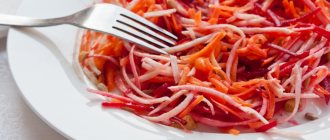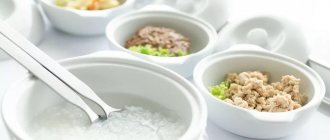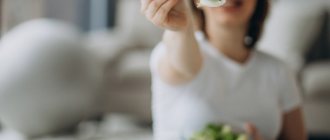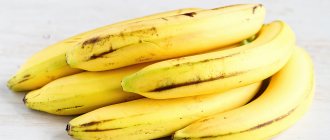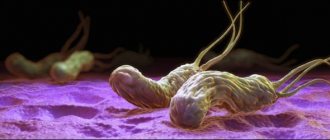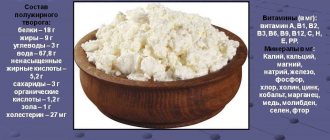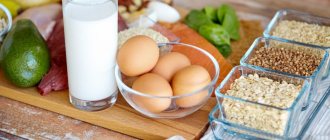The article was prepared by a specialist for informational purposes only. We urge you not to self-medicate. When the first symptoms appear, consult a doctor.
Nutrition for diarrhea is an important component of the patient’s speedy recovery. The diet should be agreed with your doctor, especially in cases where the thinning and frequent stools were caused by serious illnesses. The goal of diet therapy for diarrhea is to reduce inflammation in the intestines and normalize digestive processes by maximally sparing the mucous membrane.
You should avoid fasting or water days, since with diarrhea, intestinal functions are not lost, and the organ is able to digest food, but in smaller volumes. Complete refusal to eat slows down the recovery process, further undermining the body's defenses.
What are the benefits of cottage cheese for diarrhea and diarrhea?
For diarrhea, gastroenterologists and nutritionists advise including foods in the menu that do not irritate the digestive tract. You should eat dishes that are warm, soft in consistency, and have a slight fixing effect. The benefit of cottage cheese lies in its unique composition.
He contains:
- easily digestible fats and proteins;
- microelements;
- minerals;
- calcium;
- phosphorus;
- choline (a substance with a vitaminizing effect, increases the body's defenses).
For diarrhea and diarrhea, the benefit of cottage cheese lies in the content of a large number of fermented milk bacteria, which are necessary for the intestines to function normally. When the body is dehydrated, a large loss of calcium occurs. Cottage cheese will help replenish the balance of substances in the body.
Freshly prepared fermented milk product prevents the proliferation of viruses and pathogenic microorganisms, stops the inflammatory process in the intestines, and normalizes its microflora.
What should you not eat if you have diarrhea?
Fatty and fried foods for diarrhea are strictly prohibited. These products will lead to more frequent bowel movements and make the stool more liquid. You should exclude dishes that cause increased gas formation, such as cabbage and legumes. They irritate the digestive tract and trigger fermentation processes.
The following drinks are not allowed during diarrhea:
- Any alcohol;
- Coffee and coffee drinks;
- Green tea;
- Carbonated drinks;
- Sweet drinks
- All juices except apple;
- Unboiled water;
- All cold and hot drinks.
The following products can harm the gastrointestinal tract during diarrhea:
- Fatty meats, meat by-products (brains, liver, kidneys).
- Canned, marinated, smoked and fatty fish.
- Butter and vegetable oils.
- Heavy cream, full fat sour cream, whole milk. These products increase fermentation processes and intestinal motility, which leads to increased watery diarrhea and bloating.
- Fresh vegetables, canned vegetables, as well as mustard, horseradish, turnips, cabbage, beets, rutabaga, mushrooms.
- Sour berries and fruits.
- Chocolate.
- Mayonnaise.
- Legumes: peas, beans.
- Soy.
- Fresh pastries, bakery products, including black bread.
Is it possible to eat cottage cheese with diarrhea and why?
Eating cottage cheese during diarrhea is necessary to quickly cope with the disease, restore and strengthen the body. With diarrhea, the water-electrolyte balance is disturbed when a large amount of fluid and calcium is lost. Fermented milk products, when used correctly, can restore impaired functioning of the gastrointestinal tract.
You need to include cottage cheese in your menu for diarrhea because:
- Cottage cheese improves digestion;
- quickly absorbed;
- suppresses harmful bacteria that colonize the intestines;
- has excellent fixing properties; cleanses the body of waste and toxins;
- has a beneficial effect on the entire gastrointestinal tract.
Note! When choosing in a store, you should give preference to fresh, low-fat cottage cheese. After normalization of digestion, you can switch to cottage cheese with 1-3% fat content. If you have upset stool, you can consume no more than 200 grams of cottage cheese per day.
How to eat cottage cheese with diarrhea
When eating fermented milk during diarrhea, it is important to follow the basic rules so as not to worsen the condition.
Can't eat cold
You should not eat a product if you have just taken it out of the refrigerator. Let it sit on the counter at room temperature for at least an hour. It is necessary that the dish is not cold. Cold drinks and food irritate the walls of the stomach and intestines.
Avoid sweet and fatty additives
You should avoid sugar, condensed milk, and sour cream, which are often used to season the dish. Sweets will negatively affect the functioning of the gastrointestinal tract and can aggravate the situation with diarrhea. Even 10% fat sour cream can have a laxative effect, which is undesirable for diarrhea.
What is best to combine with
To get the maximum benefit from cottage cheese if you have bowel movements, consume it in the following form.
- With dried fruits (excluding prunes, as they have laxative properties). You can add steamed dried apricots, raisins, and dogwood to the dish. The products are rich in microelements and are suitable for dietary nutrition for digestive disorders.
- Can be mixed with low-fat kefir or yogurt. When choosing the first option, it is worth considering the production time of the product. For diarrhea, it is better to use kefir that is not fresh (2-3 days from the date of production), then it will have a fixing property.
- Add banana, make a smoothie by blending the ingredients with a blender.
Remember, eating during diarrhea should not burden the digestive tract. During each meal, monitor the amount of food eaten and the body’s response.
Principles of nutrition for diarrhea
The daily menu for diarrhea is compiled depending on what exactly caused the development of this symptom.
However, there are general nutritional principles that must be followed:
- The intestines need to be unloaded. Therefore, you need to eat in small portions, but often, 5-6 times a day.
- The intestines should not be subjected to chemical or mechanical stress.
- It is necessary to remove from the diet foods that increase gas formation and trigger fermentation processes.
- In the first days, the diet is reduced to 20% (for severe diarrhea, up to 50%).
- The menu should include lactose-free dairy products, fermented milk drinks enriched with bifidobacteria and lactobacilli.
- You should avoid foods that stimulate increased bile secretion.
- Together with food, the body’s daily need for nutrients necessary for its life must be covered. At the same time, the volume of fats and carbohydrates is reduced, focusing on protein foods.
- Dehydration is the main danger of diarrhea, so you need to monitor the amount of fluid you drink per day.
- Food needs to be ground, steamed, boiled. Spices and herbs are not added to the dishes.
- During diarrhea, you should avoid eating raw vegetables and fruits, as they can aggravate the course of the disease.
- Food should be served warm, from +33 to +38 °C.
- Salt is limited, but you cannot completely give it up.
Is it possible to use cottage cheese for diarrhea in a child?
Cottage cheese for diarrhea has a strengthening property; it can be given to children, following the recommendations of doctors and nutritionists. The product is a healthy treat and is included in the baby’s menu from 8 months of age. Up to 3 years of age, pediatricians advise giving homemade or store-bought cottage cheese, intended specifically for baby feeding.
When making homemade cottage cheese, use low-fat milk as a base. Fatty cottage cheese will worsen the child’s condition with diarrhea and intensify its course. Store-bought cottage cheese should contain no more than 2.5% fat content.
It is necessary to give a dish to a child during diarrhea, focusing on the baby’s age and reaction to the fermented milk product. If any form is not suitable for the baby, it is better to replace it with low-fat kefir or homemade yogurt. You can give cottage cheese to children in the following forms.
Children under one year old
Up to a year only in the form of store-bought low-fat cottage cheese. For diarrhea, give no more than 1-3 teaspoons. Monitor your child's well-being. If the first portion of the product does not negatively affect the condition, you can offer the baby more cottage cheese a few hours later.
Note! Children under one year old with diarrhea should not be given cottage cheese or other foods as complementary foods. This can cause a severe allergic reaction and intestinal dysbiosis.
Baby under 3 years old
For a child under 3 years old, offer a homemade fermented milk product; you can add dried fruits and bananas to it. The serving per day should not exceed 100 grams.
For older children
Older children and preschoolers can be given cottage cheese with low-fat yogurt. It is better if both products are homemade. Portion - no more than 200 grams.
Giving cottage cheese to a child with diarrhea is necessary when the acute phase of the disease has passed and there is no dehydration. It is useful to include the product in the menu when diarrhea goes away. It will help quickly restore the intestinal microflora and improve the functioning of the gastrointestinal tract.
What can you eat if you have diarrhea?
With diarrhea, large amounts of fluid are lost. To prevent dehydration, it is necessary to replenish water reserves in the body. If a patient’s diarrhea is severe, then they recommend a gentle regime with a reduction in the menu to 50-70% for 1-2 days, but it is imperative to drink water during this time.
The liquid should be consumed immediately after another episode of diarrhea. You should drink it in small sips. You need to drink about 300 ml of water at a time, because this is how much fluid an average person loses during each act of bowel movement due to diarrhea. You should consume 2-3 liters of clean water per day.
In addition to regular water, you are allowed to drink water with added salt, black and herbal tea, apple juice, low-fat broth, jelly and compote of bird cherry and blueberries, whey.
As for food, in the first 2 days you should give preference to crackers made from rye flour, rice porridge, bananas, and mashed boiled vegetables.
Special attention should be paid to rice water. This drink is effective for diarrhea, as it allows you to achieve the following goals:
- Protect the intestinal walls from irritation;
- Normalize intestinal motility;
- Absorb and remove excess fluid from the intestinal lumen;
- Reduce flatulence;
- Replenish the deficiency of nutrients.
To prepare a healthy decoction, you will need to bring 0.5 liters of water to a boil, add 2 tablespoons of rice to the pan, and cook for 45 minutes. Cool the finished broth and drink 50 ml every 2 hours.
As health improves, the patient will be allowed to expand his diet with the following products:
- Dairy products.
When preparing porridge or vegetable purees, you can add milk diluted with water in a ratio of 1 to 3.
- Dairy products
can be consumed in its pure form - yogurt, kefir, fermented baked milk, cottage cheese. They allow you to normalize the intestinal microflora, reduce gas formation and fermentation processes. In addition, fermented milk drinks are a valuable source of calcium and protein, which the body especially needs during illness. Kefir improves the absorption of calcium, fat, and nitrogen in the intestines. This fermented milk drink has a bactericidal and antitoxic effect, which makes it possible to neutralize pathogenic flora in diarrhea caused by infectious diseases.
- Cereals in the form of porridges:
rice, buckwheat, oatmeal, egg, millet. Porridge is best cooked with water or with the addition of a small amount of milk. Porridge is allowed to be salted, but not seasoned with butter.
- Meat:
chicken, turkey, low-fat beef and veal, rabbit. The meat is boiled or steamed. Meat should be served pureed.
- Eggs
chicken are also allowed during the subsidence of the disease. You should not eat more than 1 egg per day. They are either boiled or steamed into an omelette.
- Regarding baked goods
, then you can eat crackers. If they are not available, you can simply dry regular bread in the oven. Fresh baked goods should not be included in the menu if you have diarrhea.
- Pasta.
It is permissible to eat pasta in small quantities.
- You can cook fish:
steam or boil. Preference should be given to low-fat varieties of fish, including: pollock, hake, carp, pike perch, cod.
- Vegetables.
Vegetables and fruits are not consumed raw. They are boiled, or mousses, purees, jelly, and compotes are prepared on their basis. It is allowed to include potatoes, carrots, zucchini, tomatoes, asparagus, pumpkin, bananas, apples, and quinces in the menu. Vegetables and fruits are introduced gradually, after 2-3 from the onset of diarrhea. You can cook vegetable soups, prepare casseroles and soufflés.
- Berries
, from which decoctions and jelly should be prepared: dogwood, black currant, bird cherry, blueberry, thorn. All of them have a strengthening effect, which allows you to quickly get rid of diarrhea.
To avoid pressure on the stomach and intestines, portions should be kept small. During diarrhea, dishes must be added with salt, this will normalize the sodium balance in the body.
Which cottage cheese is better
You can buy a fermented milk product for your baby at a children's store. Special curds have a pleasant consistency, taste, and do not contain harmful components. During diarrhea, choose baby food without additives. Nowadays there are many cottage cheeses with original flavors of strawberry, banana, currant, etc. You can eat them if your baby is healthy.
How to make homemade cottage cheese
You can prepare the product at home, which will serve as a guarantee of quality for your baby. Cottage cheese is prepared in stages:
- take low-fat milk (if homemade, skim off the cream);
- add a 10% solution of potassium chloride (can be bought at the pharmacy chain, calculation: 19 ml of solution per 1 liter of milk);
- put on fire, bring to a boil;
- cool the resulting mixture;
- strain the product, separating the curd mass from the whey.
We also offer you recipes for making delicious and healthy homemade cottage cheese: How to make cottage cheese at home How to make amazing cottage cheese from kefir
If it is not possible to prepare the product yourself, in the store you should give preference to a product with a short shelf life. Read the composition so that it does not contain harmful components, flavors and dyes, and sugars of unnatural origin. Good and tasty cottage cheese will be crumbly, soft in taste, and not have a strong sourness.
Who should not eat cottage cheese for diarrhea and diarrhea?
Despite the fact that the dish is beneficial for the body, not everyone can consume it during periods of stool upset. Cottage cheese is contraindicated for the following people.
- With individual intolerance to fermented milk products. Eating such a dish during diarrhea will cause a strong reaction, including Quincke's edema.
- You should not eat cottage cheese if you have cholelithiasis (cholelithiasis) or pancreatitis. In this case, the dish can be included in the menu after diarrhea has passed for recovery. You should eat a low-fat product in small portions.
- If you have kidney problems. Stool disorder dehydrates the body, which affects the condition of the organ. Cottage cheese is rich in protein, which will be too much for the kidneys.
- You should not eat food with sugar if you have diabetes.
- If you are lactose intolerant, it is better to include the product in your diet during the recovery period.
